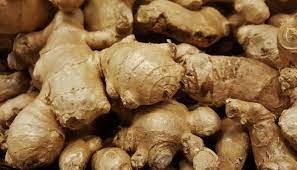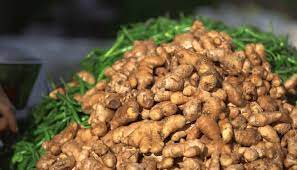Looking for a Ginger farming guide in Nigeria plus a business plan to go with alongside. Read this article as an agricultural enthusiast or an academic to know more.
The fragrant rhizomes of ginger, which are produced for both culinary and medicinal purposes, constitute a significant economic crop. The dried rhizome of ginger is used in trade. It is sold in a variety of forms, including fresh ginger, dried ginger, bleached dry ginger, powdered ginger, oil, oleoresin ginger, ginger beer, ginger ale, candy ginger, brined ginger, wine ginger, squash ginger, and ginger flakes. The rhizome of the herbaceous perennial Zingiber officinale Rosc., which is said to have originated in south-eastern Asia, is ginger. It spreads by use of rhizomes. 30-90 cm tall, upright, green stems are produced by the rhizomes. The stem is encased by the base of the leaves. The leaves are lance-shaped, 15-20 cm long, slender, and have a noticeable midrib. Small, spotted, yellowish blooms with purple speckled lips are carried on spikes. The green leaves start to turn yellow when the plants are around nine months old. In India, ginger is mostly grown for home use; very little is exported.

DOWNLOAD THIS GINGER FARMING BUSINESS PLAN
we will reveal in this Ginger farming guide, that Ginger thrives in a warm, muggy environment. It can be grown both under rainfed and irrigated circumstances, and it is mostly farmed in the tropics from sea level to an altitude of above 1500 MSL. Ginger needs a considerable amount of rain from the time it is sown until the rhizomes emerge, somewhat heavy and evenly spaced rains during the growing season, and dry weather for approximately a month before harvesting.
Soil requirement for Ginger plantation

The ideal soils for ginger growth include red loam, lateritic loam, clay, or sandy loam. Ideal soil is a friable, humus-rich loam. Ginger is a labor-intensive crop, therefore it might not be ideal to grow it in the same location each year. Though it is also often planted in open spaces, it does well in partial shade.
Ginger may be produced organically as a companion or mixed crop as long as all the other plants are also grown that way. Plants that provide shade, such as banana, pigeon pea, tree castor, and cluster bean (guar), may be interplanted with it. On the west coast, ginger is planted with young coffee, oranges, and coconuts as a mixed crop.
Land preparation for Organic Ginger Plantation

It is possible to use minimum tillage techniques while preparing the soil. To provide at least 50 cm of space between beds, beds that are 15 cm high, 1 m wide, and conveniently long can be made. The solarization of the beds helps prevent the spread of disease- and pest-causing organisms. By using the solarization process, wet beds in the field are entirely wrapped in polythene sheets and left out in the sun for 20–30 days. After the process is over, the polythene sheets used for soil solarization should be carefully stored away.
Varieties of Ginger
| Varieties of Ginger in India | |
| High dry ginger | Maran, Nadia, and Karakkal |
| High oleoresin | Ernad Chernad, China, and Rio-De-Janeiro |
| High volatile oil | Sleeva Local, Narasapattam, and Himachal |
| Green ginger | Rio-De-Janeiro, China, Wynad Local, Maran, and Varadha |
Ginger Cultural practices

An essential step in growing ginger is covering the beds with green leaves. It contributes to the conservation of soil and water in addition to being an organic manure. Three times after planting, at a rate of 4 to 5 tonnes per acre, green leaves of ginger may be used as a mulch to improve germination, boost organic matter, retain soil moisture, and reduce soil washing from severe rains. At 40 and 90 days after planting, it is repeated at a rate of 2 tonnes per acre, ideally while weeding, hoeing, and building up the soil. Leaves from Vitex negundo and Lantana camara can be used as mulch to help control the growth of shoot borer. After each mulching, liquid manure or cow dung slurry can be applied to the bed to increase nutrient availability and microbial activity.
Pests and Diseases, Control Measures of Ginger Plants
The primary pest affecting ginger growing is the shoot borer. For effective pest management, phytosanitary measures must be used together with routine field surveillance. It emerges between July and October. Find the borer-infested shoots, cut them open, remove the caterpillars, and kill the shoots. Neem oil (0.5%) may be sprayed every two weeks if necessary. The adult moths can be attracted to and captured using light traps.
The main disease affecting ginger production is soft rot, often known as rhizome rot. When choosing a location for ginger production, care should be given to ensure that the land is well-drained because standing water makes plants more susceptible to disease. Since this disease is transmitted by seeds, choose seed rhizomes from disease-free areas. The solarization of the soil during bed preparation can lower the fungal inoculum. To stop the spread of the illness, however, the soil around the rhizome and the damaged clumps must be carefully removed. Trichoderma can be used both at planting time and thereafter, if necessary. As a spot treatment, Bordeaux mixture (1%) may be used with caution in disease-prone areas to manage the condition.
Harvesting, Curing, and Yield of Ginger
Depending on the variety’s maturity, the ginger crop takes 8 to 10 months to reach harvestable size. When completely grown, the pseudostems start to dry out and the leaves turn yellow. Either a spade or a digging fork is used to lift rhizomes. They are freed of soil adhesions and soil roots.
To make it easier to peel the green ginger, it is soaked in water. With the help of pieces of pointed bamboo, the skin is scraped off. The scraped product is hand-rubbed after being rinsed, dried in the sun for three to four days. It is once more soaked in water for two hours, dried, and finally scrubbed to get rid of every last shred of skin. Produce is also bleached while sun drying. Peeling needs to be done carefully and professionally. Since the epidermal cells contain the essential oil that gives ginger its fragrant flavor, excessive or negligent scraping will result in cell damage and the loss of essential oils. Since steel knives tend to discolor vegetables, they are seldom utilized. Longer-term dry ginger storage is not recommended. Depending on the type and region where the crop is cultivated, the production of dried ginger ranges from 15 to 25 percent of that of fresh ginger. It is forbidden to burn sulfur to prepare ginger.
Green ginger is thought to generate an average of 6 to 10 tonnes per acre. Dry ginger has a recovery rate that ranges from 16 to 25%.
Now that you are done reading the Ginger farming guide in Nigeria, get a business plan alongside.
How To Download The Complete Ginger Farming Business Plan In Nigeria
Above is a part of the ginger business plan in Nigerian. If you want a complete business plan, follow the procedures to download it.
Pay the sum of N8000 (Eight thousand naira only) to the account detail below:
Bank: GTBank
Name: Oyewole Abidemi (I am putting my name and not our company account so you know we are real people and you can trust us)
Ac/No: 0238933625
Type: Saving
Thereafter, send us your email address through text message to +234 701 754 2853. The text must contain the title of the business plan you want and also your email address. Immediately after the confirmation of your payment, we will send the ginger business plan in Nigeria to your email address where you can easily download it.
